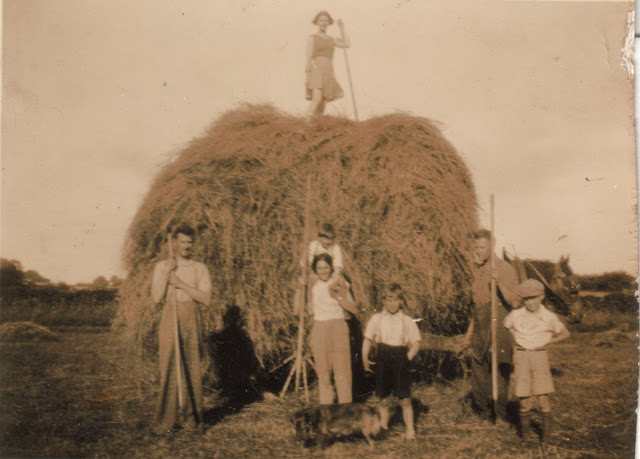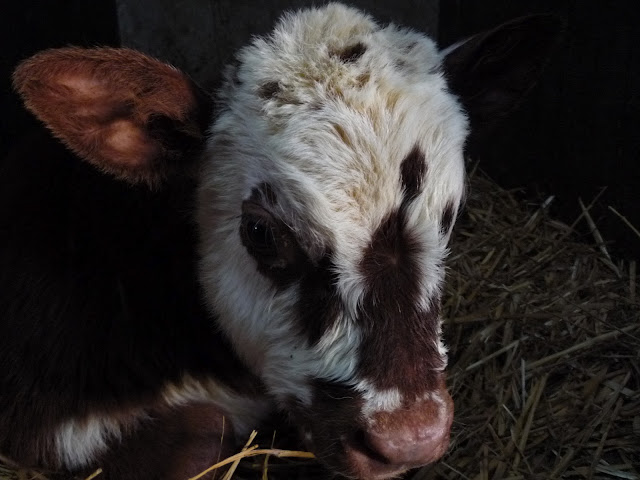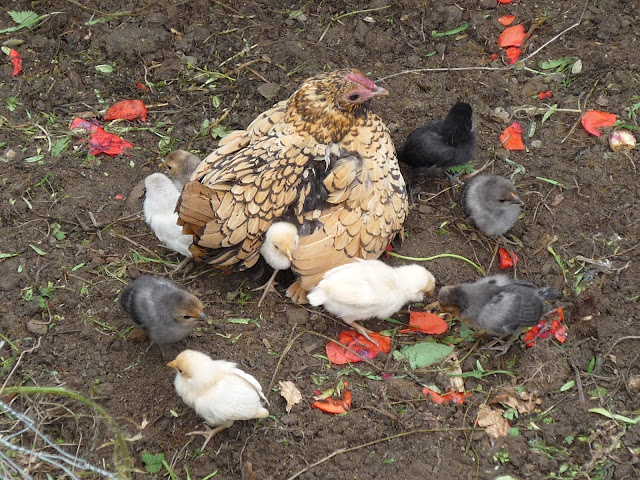Clogs to clogs:- New baby chicks, the pride and joy of my Great Grandma, who along with her husband was joint farmer and innkeeper at the sign of the Black Hamburg. During the First World War and by popular demand of the regulars, the Inn sign was repainted for what was seen as a more patriotic Old English Game Cock.

(Perhaps one of the most famous breeders of the Black Hamburg was L. Frank Baum, author of The Wonderful Wizard of Oz. In his sequel to the latter he replaced Dorothy's companion Toto with Billina, a hen, whose character is thought to be drawn from his experience in raising Hamburgs.)

Making hay whilst the sun still shines on the small farmer in the early 30's. My Grandmother atop the hay wain.

City meets Country between the Wars. My great Aunt down on the Farm having come up from the Bright Lights of London.
The Second World War sounded the death knell for so many of the hundreds of different and often ancient breeds of poultry, particularly in Europe. To begin with, there were the actual physical deaths and displacement which war wrought on farm animals, the Normandy cow, for example, was almost wiped out in the intense fighting in the region.
 This ancient race was brought to Normandy by the Vikings in the 9th century but conflict in Normandy during WWII, decimated the breed. Florence (above) is a new addition to the dairy herd on the organic farm, where I buy my grain, as are those below from a local organic farm, where I buy my raw organic milk.
This ancient race was brought to Normandy by the Vikings in the 9th century but conflict in Normandy during WWII, decimated the breed. Florence (above) is a new addition to the dairy herd on the organic farm, where I buy my grain, as are those below from a local organic farm, where I buy my raw organic milk.
In the wake of both World Wars, came the concerted push to try out all the new chemical and mechanical farming systems, which had their inception prior to WW1 but advanced in leaps and bounds after 1945. Subsidies were created purely to fund farmers in the use of these chemicals and hedges and habitats were ripped out to make way for the giant bank-funded machinery. In a World of Agrochemicals and Intensive Farming, a slow growing, independently-minded, hardy forager, had no place and ancient breeds of poultry, for example, were systematically downgraded to 'hobby hens' purely for exhibition and show. Intensive indoor systems required docile, plain-feathered birds, who could survive and lay in close confinement, the White Leghorn was in the ascendancy. Finally, even this warm-weather breed from Italy could not suffice as a laying machine and new hybrids both for meat and laying came out of the laboratory and onto the market. Meat breeds were created, which had been devised to sit at food troughs eating 24/7 and killed at 41 days and hens which sat, laid and lived in a cage no bigger than a sheet of A4 paper and so it continues, to featherless GMO hens. To summarise, two forces in Agriculture and Horticulture have been at war ever since the actual World Wars. There can be no quarter given, they are diametrically opposed, the philosophy of each precluding the existence of the other. In recent years and to back up the organic farming movement has arisen the organic homesteader, permaculturist and biodynamic backyard farmer, who is a supporter of old breeds, old methods and old skills. On the side of the Agrochemical industry are the Biotech companies, patenting the gene pool, limiting, standardising and globalising production and increasing the use of chemicals. Today the stakes are even higher.
 As more and more people come to understand the important effect of food on their health and happiness the more questions will be asked as to how that food is produced. In the meantime an increasing number of us are deciding that as food is the most important factor to sustain life, then we would be better off producing it ourselves. If you are going to do this, then you really have to be organic, otherwise all the hard work and effort you put in, will still produce an inferior product. There is also an added bonus beyond the production of good quality food and that is the insight keeping poultry gives into the workings of not only an avian society but also of our own. Studying hens is far from boring, their societies and relationships are incredibly complex and individually and as a group they are capable of adapting to change with a logic which is startling. Here below, a group of hens sunbathing together, make the vital production of vitamin D3 into a social event!
As more and more people come to understand the important effect of food on their health and happiness the more questions will be asked as to how that food is produced. In the meantime an increasing number of us are deciding that as food is the most important factor to sustain life, then we would be better off producing it ourselves. If you are going to do this, then you really have to be organic, otherwise all the hard work and effort you put in, will still produce an inferior product. There is also an added bonus beyond the production of good quality food and that is the insight keeping poultry gives into the workings of not only an avian society but also of our own. Studying hens is far from boring, their societies and relationships are incredibly complex and individually and as a group they are capable of adapting to change with a logic which is startling. Here below, a group of hens sunbathing together, make the vital production of vitamin D3 into a social event!

Here are some tiny gardeners. After our Wild poppy border had died back I used Lucky and her chicks to clear the ground before planting out a salad crop. The tiny feet do little damage to the soil structure but their big appetites clear the ground of wireworms and woodlice.
Sue
RETURN TO CONTENTS PAGE
© Holistic Hen 2015

(Perhaps one of the most famous breeders of the Black Hamburg was L. Frank Baum, author of The Wonderful Wizard of Oz. In his sequel to the latter he replaced Dorothy's companion Toto with Billina, a hen, whose character is thought to be drawn from his experience in raising Hamburgs.)
Old breeds versus New Money
Thumbing through old horticultural magazines of the mid 1800s one finds included in their columns information on poultry, pigeons and bees. The editorial carries special features on specific breeds and a lively question and answer column shows that backyard poultry was alive and kicking. A glance through the prize winners in the individual breed sections of the Poultry Show results therein, reveals a fair sprinkling of the first and second estate but not exclusively. By the time poultry reaches the novels of the 30's, country people, such as Dorothy L. Sayers' spinster and prime suspect in Busman's Honeymoon is described as keeping Buff Orpingtons, a heavy, dual purpose utility breed. Up to this date a reader of a crime novel would still be expected to know about specific breeds of poultry. By the early 30s however, in the US, the battery farming of hens had reared its ugly head, along with the growing usage of pesticides and synthetic fertilisers. In the 1920s concern over these practices had also engendered the beginnings of the Organic Movement in the UK. From the 50s onwards, main stream commercial, or what has become to be known as conventional, poultry farming went underground, or rather behind closed doors and as the decades continued people began to be less and less aware of and/or concerned with how their food was produced and in particular in what state animals and birds were kept.

Making hay whilst the sun still shines on the small farmer in the early 30's. My Grandmother atop the hay wain.

City meets Country between the Wars. My great Aunt down on the Farm having come up from the Bright Lights of London.
The Farmyard and Barnyard at War
 This ancient race was brought to Normandy by the Vikings in the 9th century but conflict in Normandy during WWII, decimated the breed. Florence (above) is a new addition to the dairy herd on the organic farm, where I buy my grain, as are those below from a local organic farm, where I buy my raw organic milk.
This ancient race was brought to Normandy by the Vikings in the 9th century but conflict in Normandy during WWII, decimated the breed. Florence (above) is a new addition to the dairy herd on the organic farm, where I buy my grain, as are those below from a local organic farm, where I buy my raw organic milk.
Other ancient breeds, such as the Oxford Sandy and Black pig, the most popular, friendly smallholder/homesteader pig for 300 years previously, were brought to the edge of extinction by the move towards faster growing, smaller pigs. These latter unlike the 'Plum Pudding Pig' as it was also known, were to be fed on cheap grain not left to forage. Again, happily, this ancient race is growing in popularity and if you want to see some in a beautiful woodland setting, then take a look at them on my sister's small organic farm in Scotland.
In the wake of both World Wars, came the concerted push to try out all the new chemical and mechanical farming systems, which had their inception prior to WW1 but advanced in leaps and bounds after 1945. Subsidies were created purely to fund farmers in the use of these chemicals and hedges and habitats were ripped out to make way for the giant bank-funded machinery. In a World of Agrochemicals and Intensive Farming, a slow growing, independently-minded, hardy forager, had no place and ancient breeds of poultry, for example, were systematically downgraded to 'hobby hens' purely for exhibition and show. Intensive indoor systems required docile, plain-feathered birds, who could survive and lay in close confinement, the White Leghorn was in the ascendancy. Finally, even this warm-weather breed from Italy could not suffice as a laying machine and new hybrids both for meat and laying came out of the laboratory and onto the market. Meat breeds were created, which had been devised to sit at food troughs eating 24/7 and killed at 41 days and hens which sat, laid and lived in a cage no bigger than a sheet of A4 paper and so it continues, to featherless GMO hens. To summarise, two forces in Agriculture and Horticulture have been at war ever since the actual World Wars. There can be no quarter given, they are diametrically opposed, the philosophy of each precluding the existence of the other. In recent years and to back up the organic farming movement has arisen the organic homesteader, permaculturist and biodynamic backyard farmer, who is a supporter of old breeds, old methods and old skills. On the side of the Agrochemical industry are the Biotech companies, patenting the gene pool, limiting, standardising and globalising production and increasing the use of chemicals. Today the stakes are even higher.
The Second Agrarian Revolution and Backyard Organics
Taking a Break - Chamois White laced Polish Crested, Silver Duckwing Ardenners and Polish/Sebright/Ardenner crosses - Willing Workers on Organic Smallholding/Forest Garden.
 As more and more people come to understand the important effect of food on their health and happiness the more questions will be asked as to how that food is produced. In the meantime an increasing number of us are deciding that as food is the most important factor to sustain life, then we would be better off producing it ourselves. If you are going to do this, then you really have to be organic, otherwise all the hard work and effort you put in, will still produce an inferior product. There is also an added bonus beyond the production of good quality food and that is the insight keeping poultry gives into the workings of not only an avian society but also of our own. Studying hens is far from boring, their societies and relationships are incredibly complex and individually and as a group they are capable of adapting to change with a logic which is startling. Here below, a group of hens sunbathing together, make the vital production of vitamin D3 into a social event!
As more and more people come to understand the important effect of food on their health and happiness the more questions will be asked as to how that food is produced. In the meantime an increasing number of us are deciding that as food is the most important factor to sustain life, then we would be better off producing it ourselves. If you are going to do this, then you really have to be organic, otherwise all the hard work and effort you put in, will still produce an inferior product. There is also an added bonus beyond the production of good quality food and that is the insight keeping poultry gives into the workings of not only an avian society but also of our own. Studying hens is far from boring, their societies and relationships are incredibly complex and individually and as a group they are capable of adapting to change with a logic which is startling. Here below, a group of hens sunbathing together, make the vital production of vitamin D3 into a social event!
In tandem with continuing research into poultry behaviours and animal sentience, which support hypotheses obvious to those of us who care for our poultry, there is another element. Our awareness that the keeping of animals is a sacred trust and that because of that trust we should keep them well. If you wish to school yourself in the aspects of diet or good parenting then you need look no further than the barnyard. Where poultry fall prey to disorder in their flock or habits it can usually be traced back to something imposed upon them by humankind. In my experience chickens do not overeat, nor do they become obese, furthermore they actually do not over-consume any of the individual elements of their diet. Put your hens in the compost heap and they will feed themselves on woodlice to a certain point and then stop and go off to look for greenery. Conversely, when they do not get enough greenery they will then start to attack your flowers and shrubs.

Here are some tiny gardeners. After our Wild poppy border had died back I used Lucky and her chicks to clear the ground before planting out a salad crop. The tiny feet do little damage to the soil structure but their big appetites clear the ground of wireworms and woodlice.
Over the next few posts I will look at some of the breeds of chicken I have kept and how their dispositions and characteristics make them ideal allies and companions in the pursuit of sustainability and self-sufficiency.
Thanks for dropping by and do feel free to share experiences or ask for further information in the comment section. If you have enjoyed this piece and found it useful think about sharing it with your family and friends, on social media and also maybe about joining this blog and/or subscribing to my Youtube, Odysee or BitChute Channel or even supporting us on Patreon or
It all helps to keep me going!
Until next time, all the very best from sunny Normandie!
RELATED POSTS
Polish Crested - Beauty, Brains and Rusticity.
It's hard to believe that a creature which looks so frou-frou can be anything but ornamental and therefore totally unsuited to a backyard or smallholding but in the following article...read more
RETURN TO CONTENTS PAGE
© Holistic Hen 2015





